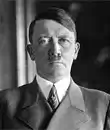
COMMAND(S):
Edward Rydz-Smigly; Waclaw Stachiewicz
ARMY FORCE(S):
Polish National Army
Edward Rydz-Smigly; Waclaw Stachiewicz
ARMY FORCE(S):
Polish National Army
AXIS VICTORY
COMMAND(S):
Fedor von Bock; Gerd von Rundstedt
ARMY FORCE(S):
Army Grp North (GER); Army Grp South (GER); Belorussian Front (SOV); Ukrainian Front (SOV)
Fedor von Bock; Gerd von Rundstedt
ARMY FORCE(S):
Army Grp North (GER); Army Grp South (GER); Belorussian Front (SOV); Ukrainian Front (SOV)
Day-by-Day Timeline of Events
Friday, September 8th, 1939
General Guderian's tank force reaches the Bug River just east of the Polish capital.
Friday, September 1st, 1939
German airborne elements begin bombardment of Polish defensive targets. At 6:00 AM, 50 German divisions making up Army Group North and Army Group South flood into Poland. Army Group South's mission is the capture of the Polish capital of Warsaw.
Sunday, September 3rd, 1939
Britain declares war on Germany leading British Prime Minister Neville Chamberlain to arrange a war cabinet.
Friday, September 8th, 1939
German ground forces arrive at the outskirts of the Polish capital of Warsaw, covering an astounding 200 miles in a single week.
Saturday, September 9th, 1939
Polish Poznan army units launch a counter-offensive against the German army at Kutno on the Bzura.
Sunday, September 17th, 1939
Soviet army elements begin their invasion of Poland from the east. Attacks occur near Vilnius and Bialystok.
Sunday, September 17th, 1939
Polish resistance at the Bzura River north of Lodz finally surrender to the Germans. Some 170,000 Polish prisoners are taken captive.
Monday, September 18th, 1939
The Polish government flees to Romania and is held. A government-in-exile is hastily arranged.
Tuesday, September 19th, 1939
German and Soviet army elements finally meet one another in Poland at Brest-Litovsk.
Thursday, September 28th, 1939
Polish forces fighting it out at the Modline fortress officially surrender.
Sunday, September 10th, 1939
Polish forces at the Modline fortress some 20 miles north of Warsaw fall under siege to the German Army.
Friday, September 29th, 1939
The German-Soviet Boundary Friendship Treaty is signed between German representative von Ribbentrop and Soviet representative Molotov. Poland is divided into a western zone under German control and an eastern zone under Soviet control.
